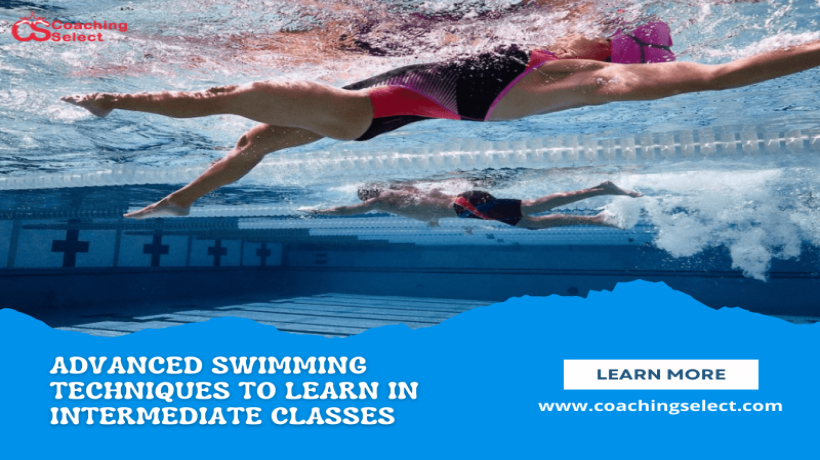Advanced Swimming Techniques to Learn in Intermediate Classes
Master advanced swimming techniques in intermediate classes. Refine strokes, perfect breathing, and boost endurance with expert instruction.
April 06, 2024

Key Takeaways:
- Intermediate swimming classes bridge mastering the basics and honing competitive-level skills.
- Learning advanced techniques like flip turns and bilateral breathing can greatly enhance a swimmer's efficiency.
- Choosing the right intermediate class is crucial and contingent on individual swimming goals and preferences.
Expanding Your Swimming Skills
As swimmers progress past the elementary stages of learning to swim, they encounter the challenging yet rewarding world of intermediate swimming. This stage is crucial for those who aspire to move into advanced swimming or even competitive swimming arenas. To build upon the essential skills mastered during initial lessons, it’s essential to advance to an intermediate level where techniques are refined and new skills are tackled. Enrolling in swimming classes near me can be the key to unlocking these new skills, ensuring a structured approach and professional guidance.
In intermediate classes, swimmers dive deeper into the principles of water dynamics and how to use their bodies to move through the water efficiently. The pedagogy combines technical refinement and endurance training, fostering a harmonious relationship between swimmers and water. This stage is about fine-tuning one's technique to streamline movements and increase swimming speed. Swimmers become more attuned to their strengths and weaknesses, and this self-awareness is pivotal for further development.
Intermediate Techniques to Master
The leap to intermediate swimming classes introduces advanced techniques, each designed to enhance aquatic prowess. These include mastering flip turns, an essential component for serious swimmers, particularly useful in lap swimming and competitive races. Flip turns allow a seamless transition between laps, conserving energy and maintaining momentum. Another critical skill is bilateral breathing; it is the ability to breathe on both sides while swimming freestyle, which promotes balanced muscle use and better oxygen distribution, a game-changer for long-distance swimming.
Swimmers at this stage also focus heavily on stroke improvement, especially with the more complex butterfly and breaststroke. With its undulating motion, the butterfly requires precise timing and rhythm, while the breaststroke demands a synchronized dance of arms and legs. Mastering these strokes is about more than just technique; it is also about finding a pace and rhythm that is both effective and sustainable. As swimmers work to perfect these advanced techniques, feedback from instructors and peers becomes invaluable, offering insights into small but significant adjustments that can lead to big improvements.
The Benefits of Advanced Swim Training
Delving into advanced swim training yields many benefits, transcending the physicality of the sport. Physically, swimmers will notice improvements in stamina, strength, and overall fitness. However, the advantages extend into mental well-being and personal growth. As swimmers accomplish new feats, they experience increased confidence, a powerful byproduct of facing and overcoming aquatic challenges. Moreover, this newfound self-assurance often permeates other aspects of life, positively impacting the swimmer's mentality.
In addition to developing physical and mental fortitude, advanced swim training equips enthusiasts with the skills necessary to enjoy various water-based activities safely. Whether participating in triathlons, exploring open water environments, or embarking on aquatic fitness endeavors, the foundation established through advanced swimming classes is pivotal. Swimmers can revel that they have taken significant strides in injury prevention through proper technique, assuring themselves of safer and more enjoyable water experiences.
Finding the Right Intermediate Swimming Class
The journey to selecting the right intermediate swimming class is deeply personal and influenced by each swimmer’s unique objectives and learning style. For some, the primary goal may be to improve health and fitness; for others, the aspiration might be to compete or engage in more rigorous water sports. This calls for a thoughtful approach when choosing a program that aligns with those goals. Lessons should be challenging enough to elevate one’s skillset but also be supportive and encouraging, fostering an enjoyable learning environment.
It is helpful for swimmers to conduct thorough research, through online reviews or consulting fellow swimming enthusiasts. Program context is vital; whether it's a community center offering classes or a specialized swim club providing targeted training, each setting brings nuances to the learning experience. Ultimately, the commitment to enhancing swimming skills through intermediate classes is an investment in oneself, leading to a richer, more rewarding relationship with the joyous realm of water activities.

